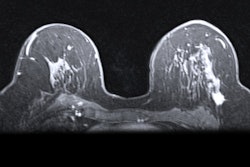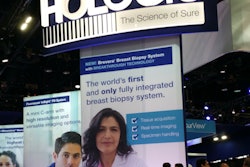
The screening performance of digital mammography can be negatively affected by the density of a woman's breast tissue -- especially tissue that is considered heterogeneously or extremely dense, according to a Spanish study published online on 15 November in the European Journal of Radiology.
Because more than a fifth of women fall into these two density categories, the study findings underscore the need for supplemental imaging for these patients, noted a group of researchers led by Dr. Margarita Posso, PhD, of the Hospital del Mar Medical Research Institute in Barcelona.
"Almost 21% of mammograms in our cohort ... were classified as BI-RADS 3 or BI-RADS 4 [heterogeneously or extremely dense], which represent a large proportion of screened women," the team wrote. "Thus, to study breast density is helpful to better planning in the screening process and [marshalling] resources needed, especially for women with dense breasts."
Posso and colleagues sought to assess the effect of breast density on screening performance in a population-based program. They included 177,164 women between the ages of 50 and 69 who underwent 499,251 digital mammograms between 2004 and 2015.
Of these women, 24.7% were classified as BI-RADS 1 (fatty), 54.7% as BI-RADS 2 (scattered fibroglandular), 14% as BI-RADS 3 (heterogeneously dense), and 6.6% as BI-RADS 4 (extremely dense). The team also categorized women according to age, with 56.1% of women between the ages of 50 and 59 and 43.9% between the ages of 60 and 69.
Women in the BI-RADS 3 category had the highest cancer detection rate, at 5.9 per 1,000 exams, while women in the BI-RADS 4 category had the highest interval cancer rate, at 2.4 per 1,000 exams, the researchers found.
| Performance measures for screening mammography according to density categories | ||||
| Performance measure | BI-RADS 1 | BI-RADS 2 | BI-RADS 3 | BI-RADS 4 |
| Cancer detection rate (per 1,000 exams) |
2.8 | 4 | 5.9 | 5 |
| Interval cancer rate (per 1,000 exams) |
0.34 | 1 | 1.9 | 2.4 |
| False positives (per 1,000 exams) |
2.4 | 5.4 | 7.5 | 8.4 |
| Sensitivity | 89.2% | 79.4% | 75% | 67.9% |
| Specificity | 97.5% | 94.5% | 92.4% | 91.5% |
| Positive predictive value of recall | 10.4% | 7% | 7.3% | 5.7% |
"Our results showed that high breast density has a negative effect on screening performance measures in a population-based program that uses digital mammography," the authors wrote. "Compared to women with BI-RADS 1, the group with BI-RADS 4 had over a threefold increased rate of interval cancer and false positives."
The study findings suggest that women with high breast density would benefit from supplemental screening modalities, according to the researchers.
Digital mammography's performance is "less effective for screening women with BI-RADS 3 or BI-RADS 4," they concluded. "Particularly, women aged 60 to 69 years with BI-RADS 4 showed the lowest sensitivity and higher interval cancer rate and, therefore, may be more likely to benefit from other screening technologies such as digital breast tomosynthesis."



















